Tests, Drills, Exercises
Tests, drills, and exercises are useful, cost-effective tools that have been proven to help organizations practice and refine their safety plans and procedures by identifying both capability gaps and areas for improvement. They can help to prepare individuals and build relationships among participants. The value of preparedness can be measured in lives saved, harm averted or mitigated, and a faster return to normal operations following an earthquake.
Performing drills helps to save lives and minimize injuries.
Social science research has long shown that people who practice actions are more likely to take those actions when a safety threatening event occurs, such as an earthquake or fire. Tests, drills, and exercises that repeat concepts build “muscle memory” of procedural knowledge and timely reaction. The more frequently a person practices a procedure or self-protective action, such as Drop, Cover, and Hold On, the more likely they will employ it— almost without thinking—when they receive an alert or feel shaking.
It is vital that tests, drills, and exercises reach the whole community, including but not limited to people with access and functional needs. It is important to provide preparedness guidance and opportunities to test, drill, and exercise for those who may use mobility assistance tools and are not able to drop to the floor and take cover. The ShakeAlert Communications, Outreach, Education and Technical Engagement (CEO&TE) team offers guidance in these short videos that can be used in conjunction with tests, drills, and exercises, along with many multilingual digital and print files. These resources can be found at ShakeAlert.org. The Earthquake Country Alliance also offers helpful resources here.
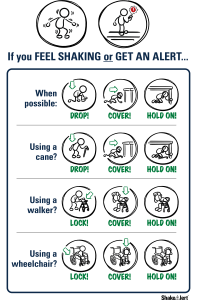
Regular drills, performed at least annually, also increase safety from secondary hazards, such as tsunamis, landslides, and aftershocks.
Incorporating a ShakeAlert EEW focus into an organization’s existing tests, drills, and/or exercises can happen in various ways and venues.
Required Drills
Schools, government agencies, and other organizations often require regular drills. Adding an EEW focus to tests, drills, and/or exercises helps participants gain important knowledge about protective action to take during an earthquake. This can be done with only minor modifications to the original test, drill, or exercise. Also, many employers require and regularly practice a variety of tests, drills, and/or exercises (e.g., fire, active shooter, or evacuation). Incorporating tests, drills, and exercises with an EEW focus is a good complement to an existing training regime, and can be conducted during staff meetings, as a stand-alone event (if it is a more extensive exercise), and during both new employee onboarding and as refresher training.
Disaster Preparedness and Awareness Events
ShakeOut – International ShakeOut Day is held annually on the third Thursday of October. This event provides an opportunity to practice Drop, Cover, and Hold On as a response in preparation for an earthquake. Incorporating a ShakeAlert EEW focus is an ideal opportunity to reinforce this advance alert.
Tsunami Preparedness Events – Washington, Oregon, and California state and local governments hold tsunami awareness campaigns and preparedness events that include tests, drills, and exercises. These are ideal opportunities to incorporate ShakeAlert EEW, since tsunamis can follow large earthquakes.
 National Preparedness Month – The Federal Emergency Management Agency (FEMA) has declared September as National Preparedness Month. State and local governments, along with organizations across the West Coast and United States, host a variety of disaster preparedness events and awareness campaigns, both in-person and virtually (visit ready.gov). This is an excellent time to incorporate ShakeAlert EEW into tests, drills, and exercises to reinforce self-protective actions, such as Drop, Cover, and Hold On.
National Preparedness Month – The Federal Emergency Management Agency (FEMA) has declared September as National Preparedness Month. State and local governments, along with organizations across the West Coast and United States, host a variety of disaster preparedness events and awareness campaigns, both in-person and virtually (visit ready.gov). This is an excellent time to incorporate ShakeAlert EEW into tests, drills, and exercises to reinforce self-protective actions, such as Drop, Cover, and Hold On.
Anniversaries of Major Earthquakes and Other Natural Hazard Events – Anniversaries of major West Coast earthquakes and other natural hazard events worldwide can be annual reminders to encourage people and organizations to think about earthquake preparedness and associated hazard mitigation measures. However, it’s important to keep in mind that these anniversaries can be particularly challenging for those who were negatively impacted by past events.
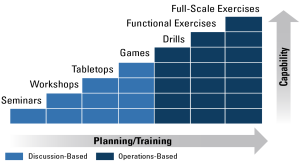 A test, drill, or exercise is an event or activity that is delivered through discussion or action to develop, assess, and/or validate plans, policies, procedures, and capabilities that organizations can use to achieve planned objectives.
A test, drill, or exercise is an event or activity that is delivered through discussion or action to develop, assess, and/or validate plans, policies, procedures, and capabilities that organizations can use to achieve planned objectives.
There are a variety of tests, drills, and exercises that can be used for specific purposes (e.g., to test and drill employees’ abilities to Drop, Cover, and Hold On when they receive a ShakeAlert-powered alert) and in different venues with varying frequencies. A test can be a simple technical assessment with the purpose of ensuring that ShakeAlert System technology that is integrated into an organization’s public address system is working properly, for instance. A short drill can be incorporated into a staff meeting, while a more expansive exercise can inject one or more scenarios to gauge an organization’s preparedness and response abilities.
Many organizations use the FEMA HSEEP model to plan, conduct, and evaluate their capabilities and address deficiencies or gaps. The USGS adheres to the HSEEP’s exercise type names and structure. The table on the next page crosswalks drill and exercise types named by HSEEP and the Earthquake Country Alliance (ECA), which organizes ShakeOut activities.
Tests
Tests are a way to assess an organization’s EEW integration system to ensure it has the technical capacity and ability envisioned to offer ShakeAlert EEW. This often includes testing of hardware, software, and any required human interventions. Some schools and hospitals, for instance, have co-located ShakeAlert EEW technology with their fire alarm systems or as independent, stand-alone alerting systems. A test of this technology may only require the participation of a small number of the organization’s leaders or technical staff. See Resources/Checklists in this Toolkit for steps to take before, during, and after a test.
There are a variety of tests, drills, and exercises that can be used for specific purposes (e.g., to test and drill employees’ abilities to Drop, Cover, and Hold On when they receive a ShakeAlert-powered alert) and in different venues with varying frequencies. A test can be a simple technical assessment with the purpose of ensuring that ShakeAlert System technology that is integrated into an organization’s public address system is working properly, for instance. A short drill can be incorporated into a staff meeting, while a more expansive exercise can inject one or more scenarios to gauge an organization’s preparedness and response abilities.Many organizations use the FEMA HSEEP model to plan, conduct, and evaluate their capabilities and address deficiencies or gaps. The USGS adheres to the HSEEP’s exercise type names and structure. The table on the next page crosswalks drill and exercise types named by HSEEP and the Earthquake Country Alliance (ECA), which organizes ShakeOut activities.TestsTests are a way to assess an organization’s EEW integration system to ensure it has the technical capacity and ability envisioned to offer ShakeAlert EEW. This often includes testing of hardware, software, and any required human interventions. Some schools and hospitals, for instance, have co-located ShakeAlert EEW technology with their fire alarm systems or as independent, stand-alone alerting systems. A test of this technology may only require the participation of a small number of the organization’s leaders or technical staff. See Resources/Checklists in this Toolkit for steps to take before, during, and after a test.
| HSEEP TYPE | ECA TYPE |
|---|---|
| DRILL A drill is a coordinated, supervised, operations-based activity to test a single, specific operation or function within an organization (e.g., people take a protective action, such as Drop, Cover, and Hold On or a modified protective action) when an EEW is received). |
Level 1 (Simple: Information-sharing related to DROP-COVER-HOLD ON)
Level 2 (Basic: Life Safety) |
| TABLETOP EXERCISE (TTX) A TTX is discussion-based and involves key personnel who discuss simulated scenarios in an informal setting. TTXs can be used to assess plans, policies, and procedures, including policies asking employees and or patrons/visitors to adhere to protective actions (Drop, Cover, and Hold On or a modified protective action) when an EEW is received. |
Level 3 (Intermediate: Decision-Making, Discussion-Based |
| FUNCTIONAL EXERCISE (FE) FEs are operation-based activities designed to test personal, decision-making, procedures, and equipment. They simulate a crisis situation to assess how equipment and participants respond. They can range from very simple to very complex and are played out in real time with simulated hazards and situations. |
Level 4 (Advanced: Operations Drill) |
| FULL SCALE EXERCISE (FSE) FSEs are the most complex and resource-intensive type of operations-based exercise that requires significant time and coordination to plan, execute, and evaluate. They often involve large sites and multiple agencies, organizations, and jurisdictions in real time, and often include simultaneous scenarios. |
Level 4 (Advanced: Operations Drill) |
Discussion-Based Exercises
Seminars, Workshops, Tabletop Exercises, Games
Discussion-based exercises involve a bit more preparation and participation than tests, and include seminars, workshops, tabletop exercises (TTXs), and games. These types of exercises familiarize participants or “players” with or task them to develop new plans, policies, and/or procedures. They are led by facilitators or presenters who keep participants moving towards exercise objectives.
Seminars are effective for all group sizes. With limited time constraints, seminars aim to achieve a common framework of understanding. Seminars are usually led by a facilitator, are lecture-based, and elicit minimal participant feedback. Workshops may include lectures and presentations but are deliberately structured to be engaging.
Workshops include breakout sessions that are guided by a facilitator who sets clear objectives to help prompt discussion from engaged participants.
Tabletop Exercises (TTX) are designed to generate in-depth discussion in a problem-solving environment. A scenario is presented to describe an event at a simulated time. Players apply their knowledge and skills to a list of problems presented by an experienced facilitator. TTX may include presentations; however, the majority of “work” is done in plenary or breakout sessions.
Games are a structured form of play designed for individuals or teams in a competitive or noncompetitive environment. Games are guided by clear rules, data, and procedures. They are designed to depict an actual or hypothetical situation to ensure that the participants make decisions and take plausible actions. Games can be used to reinforce training, stimulate team building, or enhance operational and tactical capabilities. Check out some of these games suggested by the National Academy of Sciences.
See Resources/Checklists in this Toolkit for steps to take before, during, and after discussion-based exercises.
Operations-Based Exercises
Operations-based exercises include drills, functional exercises (FE), and full-scale exercises (FSE). These exercises validate plans, policies, and procedures; clarify roles and responsibilities; and identify resource gaps. Operations-based exercises include a real-time response action, such as Drop, Cover, and Hold On or other self-protective actions. Drills and exercises differ by their scope and complexity.
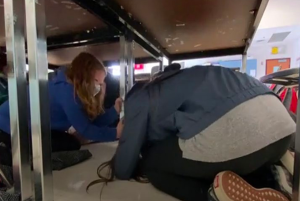
Drills, Functional and Full-Scale Exercises
Drills test a single function (e.g., fire drill, evacuation drill). They provide training on equipment, validate procedures, or practice and maintain current skills, such as Drop, Cover, and Hold On or modified protective actions. They can be conducted as standalone events or as a series. Clearly defined plans, procedures, and protocols need to be in place so participants know what is expected of them.
Functional Exercises (FE) are operation-based activities designed to test personnel, decision-making, procedures, and equipment. They simulate a crisis situation to assess how equipment and participants respond. Functional exercises can range from very simple to very complex. Typically, they are stressful, as the scenario is played out in real time with simulated hazards and situations, known as injects. Generally, functional exercises test some component(s) of an organization’s Emergency Operation Plan (EOP), and/ or its Continuity of Operations Plan (COOP), and involve the highest levels of the organization’s leaders. Functional exercises may involve multiple organizations or many divisions within a large organization. They can be effective relationship-building tools.
Full-Scale Exercises (FSE) are the most complex and resource-intensive type of exercise that requires significant time and coordination to plan, execute, and evaluate. They often involve multiple agencies, organizations, and jurisdictions in real-time scenarios. An exercise site for an FSE is usually large and accommodates many activities that occur simultaneously. Many FSEs are conducted in California, Oregon, Washington (and beyond) during the Great ShakeOut event each fall.
See Resources/Checklists in this Toolkit for steps to take before, during, and after operations-based exercises.
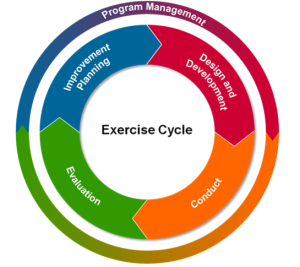 The ShakeAlert Earthquake Early Warning (EEW) System can be integrated into existing tests, drills, and/or exercises. Ranging from simple to advanced, the following drill and exercise design options include an EEW component. See Resources/Checklists in this Toolkit for steps to take before (plan), during (conduct), and after (evaluate) the test, drill, or exercise. Based on its identified purpose, objectives, scope, and available resources, each organization will determine the appropriate type of drill or exercise.
The ShakeAlert Earthquake Early Warning (EEW) System can be integrated into existing tests, drills, and/or exercises. Ranging from simple to advanced, the following drill and exercise design options include an EEW component. See Resources/Checklists in this Toolkit for steps to take before (plan), during (conduct), and after (evaluate) the test, drill, or exercise. Based on its identified purpose, objectives, scope, and available resources, each organization will determine the appropriate type of drill or exercise.
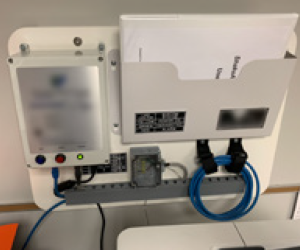
Drills and exercises, in particular, can be ideal opportunities to establish and solidify recommended protective actions during and following earthquakes. Equally important is the need to refute misinformation about self-protective best practices. Official rescue teams, emergency preparedness experts, and others recommend Drop, Cover, and Hold On (or a modified protective action for those who cannot easily drop to the floor) as the best way, in most situations, to self-protect during earthquake shaking. Running outside or standing in a doorway are dangerous or outdated recommendations, while the “triangle of life theory” is an unsubstantiated idea that doesn’t apply to countries such as the United States, where many buildings are unlikely to experience total collapse.
Technical Check of Automated EEW Systems
Test EEW integration to ensure that all components of your organization’s EEW system are working correctly.
Tabletop Exercises
A tabletop exercise (TTX) is a discussion-based exercise that usually includes a small group of the organization’s operational staff who discuss their roles, plans, resource needs, and actions as soon as the alert is received (including a Drop, Cover, and Hold On or modified protective action), and after the earthquake occurs. They can be ideal for small divisions in an agency and organizational leaders who make budgetary, policy, and safety related decisions. The duration of a tabletop exercise depends on the audience, the topic being exercised, and the objectives. Many tabletop exercises can be conducted in a few hours, so they are cost-effective tools to validate plans and capabilities.
Functional
A functional exercise (FE) simulates an emergency in the most realistic manner possible. The scope will vary, but all functional exercises are conducted in a real-time environment to test and evaluate the capability of an organization’s crisis response. The exercise could be for an earthquake alone or any scenario where an earthquake occurs, in which case the EEW could be inserted at any time during the scenario.
